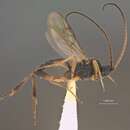Distribution
provided by Catalog of Hymenoptera in America North of Mexico
Md., Mich.
- bibliographic citation
- Catalog of Hymenoptera in America North of Mexico. 1979. Prepared cooperatively by specialists on the various groups of Hymenoptera under the direction of Karl V. Krombein and Paul D. Hurd, Jr., Smithsonian Institution, and David R. Smith and B. D. Burks, Systematic Entomology Laboratory, Insect Identification and Beneficial Insect Introduction Institute. Science and Education Administration, United States Department of Agriculture.
Comprehensive Description
provided by Smithsonian Contributions to Zoology
Orgilus fulgens
This is rather similar to longiceps Muesebeck, but it may be distinguished immediately by its much smoother abdomen. From lissus, new species, which it seems to resemble even more closely, it differs as indicated in the description of that species.
MALE.—Length 4.3 mm. Head hardly as wide as thorax, in dorsal view 0.75 as long as wide; face slightly narrower than eye height, coarsely rugulose punctate; clypeus strongly and closely punctate; malar space about one-third as long as eye height, punctate granulose; cheeks smooth and polished; anterior tentorial pits below level of lower eye margins; temples not receding, very nearly as wide as eyes, smooth and polished; vertex smooth and polished; occipital carina broadly interrupted medially; ocellocular line less than twice as long as diameter of an ocellus; antennae of holotype 33-segmented, even the shortest flagellar segments clearly longer than broad.
Thorax stout; mesoscutum smooth and shiny; notauli sharply impressed and foveolate, meeting in a very acute angle just before posterior margin of scutum; disc of scutellum small, smooth and polished; propodeum closely rugulose, even in the posterior areas that are set off by short and weak stubs of longitudinal carinae arising from the posterior margin; side of pronotum rugulose, broadly smooth above; mesopleuron smooth and polished, the longitudinal furrow sinuate and foveolate; metapleuron smooth and polished except along the lower posterior margin where it is somewhat rugulose. Hind coxa considerably more than half as long as hind femur, smooth and shiny on outer side, finely granulose on upper edge basally; hind femur stout, barely four times as long as wide; inner calcarium of hind tibia just about half as long at metatarsus; tarsal claws simple. Radial cell on wing margin as long as stigma; second abscissa of radius on a line with intercubitus; stub of third abscissa of cubitus about as long as second abscissa; nervulus slightly postfurcal; hind wing 4.5 times as long as broad; lower abscissa of basella a little longer than nervellus but less than half as long as mediella.
Abdomen on third tergite only very slightly narrower than thorax; first tergite about 1.3 times as long as broad at apex, largely finely rugulose punctate; second tergite only slightly (1.1 times) broader at base than long, largely smooth and shiny but with a closely punctate area each side of the middle on basal half; third and following tergites smooth and polished.
Black; clypeus entirely black; palpi piceous; scape black or blackish below as well as above, the flagellum yellowish brown on basal half, darker apically, legs reddish yellow, the hind coxae darkened basally; hind femora darkened on apical two-thirds; hind tibiae a little infuscated basally and on apical third; hind tarsi dark; tegulae piceous, wing bases brownish yellow; wings a little infumated.
FEMALE.—Unknown.
HOLOTYPE.—USNM 70166.
DISTRIBUTION.—Known only from two males: The holotype collected 28 June 1953, near Cumberland, Maryland, by Luella M. Walkley, and a paratype labeled only “Agr. College, Mich.”
- bibliographic citation
- Muesebeck, Carl F. W. 1970. "The Nearctic species of Orgilus Haliday (Hymenoptera: Braconidae)." Smithsonian Contributions to Zoology. 1-104. https://doi.org/10.5479/si.00810282.30

